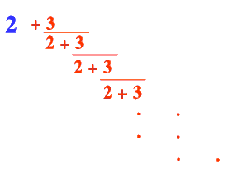Copyright © University of Cambridge. All rights reserved.
'There's a Limit' printed from https://nrich.maths.org/
Show menu
Tony of State College Area High School, Pennsylvania, USA and Chi Kin of Saint Dominic's International School, Lisbon sent in excellent solutions and here is Chi Kin's:
What happens when successive terms are taken in the continued fraction

I calculated the first five terms
$2 + {3\over2} = {7\over2} = 3.5 $
$2 + \frac{3}{2+{3\over2}} = {20\over7} = 2.86 $
The third term is $3.05$
The fourth term is $2.95$
And the fifth term is $3.02$
Thus, when successive terms are taken, the results oscillate alternately above and below $3$.
Indeed, if the fraction goes on forever, we would get $3$.
Suppose the continued fraction is denoted as $F$. Thus
$$\eqalign{ F &=& 2 + \frac{3}{F} \\ F &=& \frac{2F + 3}{F} \\ F^2 - 2F - 3 &=& 0 \\ (F-3)(F+1) &=& 0.}$$Thus $F = 3$, because $F$ cannot be negative.